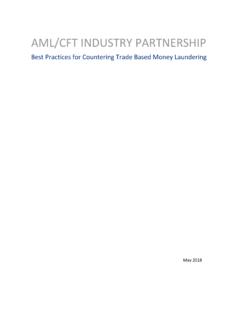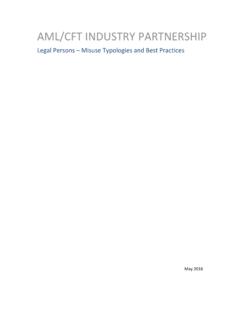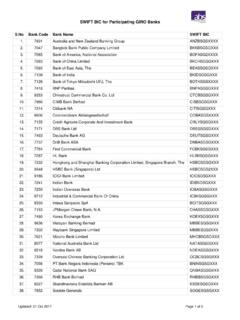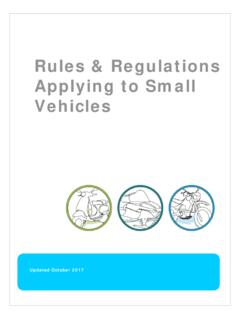Transcription of Code of Advertising Practice for Banks June2010
1 1 CODE OF Advertising Practice FOR Banks (A sub-code of the Code of Consumer Banking Practice ) 1. An advertisement is defined in the Singapore Code of Advertising Practice (2nd Ed.) as any form of commercial communication for any goods or services, regardless of medium used. 2. Media used for advertisement include: - a. publication in a newspaper, magazine, journal or other periodical b. circulars, brochures, pamphlets, books or other documents c. indoor or outdoor display of posters or notices d. radio, television, cinema, the internet or other media e. letters/fax transmissions to customers/potential customers f.
2 Non-broadcast electronic media such as computer games 3. Advertisements should be legal, clear, fair, reasonable and not be misleading. They should not mislead in any way by inaccuracy, ambiguity, exaggeration, omission or otherwise. Product labeling should not create an impression that a product has certain characteristics that it does not have. It would be an unfair Practice for an advertisement to say anything, or fail to say anything, if, as a result of which, a consumer might be deceived or misled; or if the advertisement makes a claim that is false. 4. Advertisements should be clear and easily understood by the audience being addressed. Advertisers should ensure that they do not take advantage of people's inexperience or gullibility.
3 It is an unfair Practice for the advertiser to take advantage of a consumer if the advertiser knows or should reasonably be expected to know that the consumer (a) is not in a position to protect his or her own interests or (b) is not reasonably able to understand the character, nature, language or effect of the transaction or proposed transaction or any matter related to the transaction. 5. Advertisements should indicate the nature of the contract being offered, and provide information on any limitations on eligibility, any charges, expenses, risks, penalties attached and the terms on which withdrawal may be arranged. Alternatively, if an advertisement is short or general in its content, explanatory material giving full details of the facilities or opportunities available should be readily available before a binding contract is entered into.
4 Advertisements should present a fair and balanced picture of the product being advertised. The main risks and drawbacks should also be highlighted to balance the 'headline' benefits, which should be realistic and not based only on an optimistic view of events. Effective Interest Rate 6. Any advertisement for interest-bearing deposit accounts and loan products which includes a reference to an interest rate must include the Effective Interest Rate (EIR) if the advertised Applied Rate (AR) is not the same as the EIR (except for deposit accounts with 2tiered pricing where it is not feasible to compute the EIR).
5 These advertisements should comply with the following requirements: 6a. Objective: (i) The EIR is the interest rate which reflects the total cost charged for using the loan. The EIR may be higher than the AR because of the way interest is calculated. The objective of the EIR is to disclose to customers the true cost of borrowing. Banks are obligated to disclose the AR and the EIR for every loan product so as to help customers make informed decisions. 6b. Display: (i) The EIR must be displayed side by side with the AR, with equal prominence and in the main text of the advertisement, the same font size must be used for both the AR and the EIR. (ii) The EIR must not be hidden in fine print at the footnote of the main advertisement or in the terms and conditions.
6 6c. Calculation: The calculation of the EIR is based on the following principles: (i) The calculation of the EIR for every loan product has to include all upfront administration/processing fees regardless of whether these fees are fixed or variable. (ii) Upfront administration/processing fees which vary according to the loan tenors or loan amounts must be included in the calculation of the EIR. An administration/ processing fee contains a risk premium and is considered an interest component if it varies according to the loan tenors or loan amounts. For example, promotional term loans that offer upfront administration/processing fees which vary according to the loan tenors, for 6 months, for 9 months, etc.
7 (iii) The calculation of the EIR for every loan product has to include the upfront charge to pay for insurance premium if the insurance is mandatory for the borrower. However, the upfront charge to pay for insurance premium can be excluded from the EIR calculation if: (A) the insurance is not mandatory for the borrower; or (B) the bank absorbs the upfront insurance premium charge. (iv) The calculation of the EIR should be consistent and comparable across products. To achieve this, the upfront fees and charges must be included in the loan amount for calculating the EIR, where the loan amount is indicated by PV in the EIR formula : PV = PMT (PVIFA k/m, m*n). The fees and charges included in the calculation of the EIR must be disclosed.
8 Fees and charges which are excluded from the calculation of the EIR, but which may be charged later, for example early repayment charges and default charges, must also be disclosed. 3 (v) For revolving credit facilities, the EIR should state that interest is subject to compounding if not serviced, for a revolving personal line of credit that charges 16% per annum, EIR should be stated that the EIR is 16% per annum subject to compounding if the monthly interest charges are not repaid in full. Please refer to the ABS Bye-laws and Regulations for the definition and formula for the calculation of EIR for a term loan repayable by regular monthly instalments.
9 Statutory and Other Regulatory Requirements 7. All Advertising materials must comply with all relevant laws, statutory and regulatory guidelines of Singapore. Banks must have adequate policies, procedures and systems to ensure compliance with all laws, regulations and guidelines, as well as this Advertising code. Advertising for Unit Trusts and Bancassurance 8. Advertisements for unit trusts and bancassurance must comply with the provisions of the Financial Advisers Act and Securities and Futures Act, and the related regulations and notices issued by the Monetary Authority of Singapore. These advertisements should also comply with the IMAS/LIA Code of Best practices in Advertising Collective Investments Schemes and Investment Linked Life Insurance Policies.
10 With effect from: 15 June 2010 Last revised: August 2006










